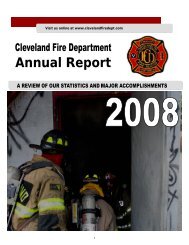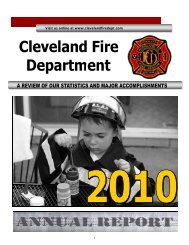SOP Manual - Cleveland Fire Department
SOP Manual - Cleveland Fire Department
SOP Manual - Cleveland Fire Department
- No tags were found...
Create successful ePaper yourself
Turn your PDF publications into a flip-book with our unique Google optimized e-Paper software.
Training and Education<br />
<strong>Cleveland</strong> <strong>Fire</strong> <strong>Department</strong><br />
Operations <strong>Manual</strong><br />
A. The <strong>Cleveland</strong> <strong>Fire</strong> <strong>Department</strong> shall operate a training and education program with the goal of<br />
preventing occupational accidents, deaths, injuries, and illnesses.<br />
B. The training and education provided to members shall address all of the applicable provisions of<br />
NFPA 1500, Standard on <strong>Fire</strong> <strong>Department</strong> Occupational Safety and Health Program.<br />
C. The <strong>Cleveland</strong> <strong>Fire</strong> <strong>Department</strong> shall provide training and education for all personnel to insure that<br />
they are able to perform their assigned duties in a safe manner that does not present a hazard to<br />
themselves or to other members of the <strong>Fire</strong> <strong>Department</strong> or general public.<br />
D. The <strong>Cleveland</strong> <strong>Fire</strong> <strong>Department</strong> shall provide training and education for all <strong>Fire</strong> <strong>Department</strong><br />
members at the level necessary for the duties and functions that they are expected to perform.<br />
E. All training and education shall be provided by individuals who are qualified to provide<br />
instruction in the subjects covered.<br />
F. Prior to assignment to a <strong>Fire</strong> Company in the field, initial training of members of the <strong>Fire</strong><br />
<strong>Department</strong> shall consist of a minimum of ten (10) weeks (400 hours). This training shall result in<br />
meeting the performance objectives of NFPA 1001, Level I and the Tennessee Commission on<br />
<strong>Fire</strong>fighting Certification.<br />
G. Training shall be provided for all members as often as necessary to meet the requirements of this<br />
policy. Each member shall participate in no less than 240 hours of documented training each year<br />
which includes 40 hours of In-Service training.<br />
H. Whenever changes in procedures or technology are introduced or new hazards are identified in the<br />
work environment, appropriate training and education shall be provided for all affected members.<br />
I. Members shall be provided with training and education appropriate for their duties and<br />
responsibilities before being permitted to engage in emergency operations.<br />
J. All members who engage in structural firefighting shall meet the minimum requirements of<br />
<strong>Fire</strong>fighter I as specified in NFPA 1001, Standard for <strong>Fire</strong>fighter Professional Qualifications<br />
and/or Tennessee <strong>Fire</strong>fighter I.<br />
K. All fire apparatus Drivers/Operators shall meet the minimum requirements specified in NFPA<br />
1002, Standard for <strong>Fire</strong> Apparatus Driver/Operator Professional Qualifications.<br />
L. All fire officers shall meet the minimum requirements for at least <strong>Fire</strong> Officer I as specified in<br />
NFPA 1021, Standard for Professional Qualifications for <strong>Fire</strong> Officers and/or Tennessee <strong>Fire</strong><br />
Officer I.<br />
M. <strong>Fire</strong> <strong>Department</strong> training officers shall meet the qualifications specified in NFPA 1041, Standard<br />
for Professional Qualifications for <strong>Fire</strong> Service Instructors and/or Tennessee <strong>Fire</strong> Instructor I.<br />
N. All members who may be involved in emergency operations shall be trained in “Incident<br />
Command”. The training program for all members engaged in fire ground operations shall include<br />
procedures to be followed to provide for their safe exit from the dangerous area in the event of<br />
equipment failure or sudden changes in fire conditions.<br />
Effective: June 1, 1997 Revised: 5/14/2009 Page | 287<br />
Approved by: Chief Chuck Atchley




